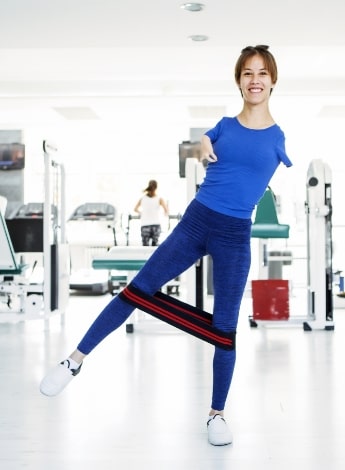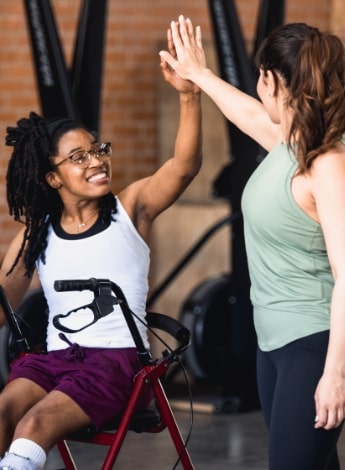
Community gym exercise for young adults with developmental disability

Georgia McKenzie, Professor Nora Shields and Dr Rachel Kennedy, investigators from the VicHealth-funded GYM-SPARC (Getting Young adults Moving by Supporting Participation and Access in Recreation Centres) research project, create five discussion points about community gym exercise for young adults with developmental disability.
1. The community gym is a preferred place to exercise for young adults with disability
Developmental disability includes disability present from birth or early childhood such as cerebral palsy and Down syndrome.
For people with developmental disability, there is often a decline in physical activity through adolescence and into adulthood (Carlon et al 2013, Pitetti et al 2013).
Physical activity guidelines for adults with disability are the same as the general population—at least 150 minutes of moderate to vigorous activity per week and strength training twice weekly (World Health Organization 2020, Verschuren et al 2016).
Many young adults with disability do not meet these physical activity guidelines, placing them at higher risk of secondary conditions like heart disease and diabetes (Pitetti et al 2013, Verschuren et al 2016).
The gym is a popular place to exercise for many young adults in Western societies (Doğan 2015).
Population-based AusPlay surveys conducted by Sports Australia have shown that adults with disability prefer to exercise in community settings, and the gym is in the top three preferred places to exercise (Hassett et al 2021).
2. Community-based gym exercise is safe and feasible for young adults with disability

Exercising in a community gym setting has been demonstrated to be safe and feasible for young adults with disability.
Young adults with disability may have worries about starting to exercise in the gym.
Concerns about knowledge, skills and injury have been reported, with young people worried about ‘doing the wrong thing’ in the gym (McKenzie et al 2022).
A large intervention trial called FitSkills (Shields et al 2021) evaluated the feasibility and safety of community gym exercise for young people with disability aged 13–30.
During the trial, 123 young people completed 12 weeks of twice-weekly exercise at their local community gym.
It was demonstrated that exercising in the gym is safe and feasible for young people with disability including cerebral palsy, Down syndrome, autism spectrum disorder and vision impairment (Shields et al 2021).
Importantly, this trial included participants with complex disability (20 per cent), who are often excluded from exercise trials.
Physiotherapists play an important role in facilitating successful participation in community gym exercise for young adults with complex disability (Shields et al 2021) and those who have concerns about commencing gym exercise.
3. The social and physical environment is an important influence on gym participation for young adults with disability

Standard gym equipment is highly adaptable and physiotherapists can support young adults with disability to adapt existing equipment for individual purposes.
Factors relating to the social environment, the physical environment and cost have been shown to influence attendance and involvement in physical activity for young adults with physical disability (Martin Ginis et al 2016, McKenzie et al 2022, McKenzie et al 2021).
Social support—that is, providing instrumental, appraisal, informational or emotional support (Berkman et al 2000)—is a key facilitator of physical activity in the gym for people with disability (Sharon-David et al 2020).
Similarly, the experience of positive social connection through inclusive behaviour by peers or staff can create a sense of belonging and allay fears about being physically active in a community setting.
Social connection can be a strong motivator to participate in, and prioritise, physical activity (McKenzie et al 2021).
Physical aspects of the gym environment—such as access, change rooms, layout, equipment and transport—are frequently reported as barriers to participation (McKenzie et al 2021).
However, standard gym equipment can also be highly adaptable.
Physiotherapists have expert knowledge in disability and exercise and have the skills to support young adults with disability to adapt existing equipment for individual purposes.
The affordability of gym entry fees and the costs of associated support needed to participate (eg, carers or transport) are other barriers to physical activity participation for young adults with disability (Martin Ginis et al 2016), who are less likely to be employed and earning high incomes (Reddihough et al 2013).
4. There are physical and psychosocial benefits from participating in community gym exercise
Gym exercise can improve cardiovascular fitness and strength for young adults with developmental disability (Rimmer et al 2004, Taylor et al 2004).
This has important implications for managing secondary comorbidities of disability including metabolic conditions.
Physical activity interventions for people with disability often focus on the physical benefits; however, young adults with developmental disability also value, and are motivated by, psychosocial benefits (Hassett et al 2021, McKenzie et al 2022).
Leisure environments provide a context that connects people, and sport and recreation can provide opportunities to develop social networks (Devine 2004, Lundberg et al 2011), while meaningful connections with others can facilitate participation in physical activity (Martin Ginis et al 2016).
Young adults who have experienced peer-supported gym exercise in the community have reported improvements in their confidence about their physical skills and capabilities.
This confidence extended beyond the gym into broader activities such as study and work.
Other psychological benefits, such as a more positive mood and improved self-efficacy, have also been reported (McKenzie et al 2022).
Physiotherapists working with young adults with disability should consider measuring physical and psychological outcomes of gym participation as part of their evaluations.
5. Social support is important for facilitating gym participation, but one size does not fit all

Social support to exercise in the gym plays a substantial role and may include practical assistance, supervision when exercising and peer support.
Having social support to exercise in the gym has been identified as a key facilitator of participation (Sharon-David et al 2020).
Social support can include things like practical assistance (such as transport or physical assistance in the gym), supervision when exercising (from a carer, trainer or allied health professional) and peer support to exercise (for example, from friends or other people with disability).
Social support preferences are unique to each person but authentic relationships with peers, family, gym staff and others in the community play a substantial role in creating positive participatory environments (Martin Ginis et al 2016).
Many young adults with disability have access to physiotherapy services through their National Disability Insurance Scheme funding.
For those with lifelong disability who are not in an acute rehabilitation phase, participation itself can be an appropriate intervention (Adair et al 2015), with sustained community gym or other physical activity participation a goal of service provision.
Physiotherapists have a role to play in collaborating with gyms to develop pathways into gym exercise and promote physiotherapists as experts in disability who can support gym staff to include people with disability in these community settings.
Working with clients to identify their preferences for ongoing social support will be critical to their experiences and connection in the gym environment.
Click here for an infographic poster version of this article.
>> Georgia McKenzie is a PhD candidate with La Trobe University and the CP-Achieve Centre of Research Excellence. Georgia’s PhD work focuses on identifying factors influencing community gym participation for adults with cerebral palsy and developing strategies to improve participation. She is a physiotherapist in the Young Adult Complex Disability Service at St Vincent’s Hospital.
>> Nora Shields is Professor of Physiotherapy at La Trobe University. Nora is a chief investigator on the National Health and Medical Research Council-funded CP-Achieve Centre of Research Excellence and leads the VicHealth-funded GYM-SPARC project at La Trobe University. Her research aims to improve the health and wellbeing of people with disability through participation in physical activity.
>> Dr Rachel Kennedy APAM is project manager of the VicHealth-funded GYM-SPARC project at La Trobe University, which aims to increase physical activity participation among young adults with disability in gyms. Rachel is also a senior clinician-research physiotherapist in neuromuscular diseases at the Royal Children’s Hospital and the Murdoch Children’s Research Institute.
- References
-
Adair, B., Ullenhag, A., Keen, D., Granlund, M., & Imms, C. (2015). The effect of interventions aimed at improving participation outcomes for children with disabilities: a systematic review. Developmental Medicine & Child Neurology, 57(12), 1093-1104.
Berkman, L. F., Glass, T., Brissette, I., & Seeman, T. E. (2000). From social integration to health: Durkheim in the new millennium. Social science & medicine, 51(6), 843-857.
Carlon, S., Shields, N., Dodd, K., & Taylor, N. (2013). Differences in habitual physical activity levels of young people with cerebral palsy and their typically developing peers: a systematic review. Disabil Rehabil, 35. doi:10.3109/09638288.2012.715721
Devine, M. A. (2004). “Being a ‘doer’instead of a ‘viewer’”: The role of inclusive leisure contexts in determining social acceptance for people with disabilities. Journal of Leisure Research, 36(2), 137-159.
Doğan, C. (2015). Training at the Gym, Training for Life: Creating Better Versions of the Self Through Exercise. Europe's journal of psychology, 11(3), 442-458. doi:10.5964/ejop.v11i3.951
Hassett, L., Shields, N., Cole, J., Owen, K., & Sherrington, C. (2021). Comparisons of leisure-time physical activity participation by adults with and without a disability: results of an Australian cross-sectional national survey. BMJ Open Sport & Exercise Medicine, 7(1), e000991.
Lundberg, N. R., Taniguchi, S., McCormick, B. P., & Tibbs, C. (2011). Identity negotiating: Redefining stigmatized identities through adaptive sports and recreation participation among individuals with a disability. Journal of Leisure Research, 43(2), 205-225.
Martin Ginis, K. A., Ma, J. K., Latimer-Cheung, A. E., & Rimmer, J. H. (2016). A systematic review of review articles addressing factors related to physical activity participation among children and adults with physical disabilities. Health Psychology Review, 10(4), 478-494. doi:10.1080/17437199.2016.1198240
McKenzie, G., Shields, N., & Willis, C. (2022). ‘Finding what works for me’ – a qualitative study of factors influencing community gym participation for young adults with cerebral palsy. Disability and Rehabilitation, 1-8. doi:10.1080/09638288.2022.2083243
Mckenzie, G., Willis, C., & Shields, N. (2021). Barriers and facilitators of physical activity participation for young people and adults with childhood‐onset physical disability: a mixed methods systematic review. Developmental Medicine & Child Neurology.
World Health Organization. (2020). WHO guidelines on physical activity and sedentary behaviour: accessed 6th Sept, 2022 from https://apps.who.int/iris/bitstream/handle/10665/336657/9789240015111-eng.pdf
Pitetti, K., Baynard, T., & Agiovlasitis, S. (2013). Children and adolescents with Down syndrome, physical fitness and physical activity. Journal of Sport and Health Science, 2(1), 47-57. doi:https://doi.org/10.1016/j.jshs.2012.10.004
Reddihough, D. S., Jiang, B., Lanigan, A., Reid, S. M., Walstab, J. E., & Davis, E. (2013). Social outcomes of young adults with cerebral palsy. Journal of Intellectual & Developmental Disability, 38(3), 215-222.
Rimmer, J. H., Heller, T., Wang, E., & Valerio, I. (2004). Improvements in physical fitness in adults with Down syndrome. American Journal on Mental Retardation, 109(2), 165-174.
Sharon-David, H., Siekanska, M., & Tenenbaum, G. (2020). Are gyms fit for all? A scoping review of the barriers and facilitators to gym-based exercise participation experienced by people with physical disabilities. Performance Enhancement & Health, 100170. doi:https://doi.org/10.1016/j.peh.2020.100170
Shields, N., Willis, C., Imms, C., McKenzie, G., van Dorsselaer, B., Bruder, A. M., . . . Prendergast, L. A. (2021). Feasibility of scaling-up a community-based exercise program for young people with disability. Disability and Rehabilitation, 1-13.
Taylor, N. F., Dodd, K. J., & Larkin, H. (2004). Adults with cerebral palsy benefit from participating in a strength training programme at a community gymnasium. Disability and Rehabilitation, 26(19), 1128-1134.
Verschuren, O., Peterson, M. D., Balemans, A. C., & Hurvitz, E. A. (2016). Exercise and physical activity recommendations for people with cerebral palsy. Developmental Medicine & Child Neurology, 58(8), 798-808. -
© Copyright 2024 by Australian Physiotherapy Association. All rights reserved.





